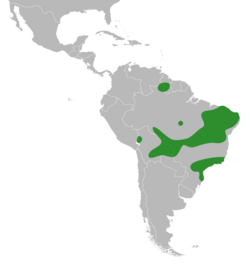Biology:Luetzelburgia
From HandWiki
Short description: Genus of legumes
| Luetzelburgia | |
|---|---|
| Scientific classification | |
| Kingdom: | Plantae |
| Clade: | Tracheophytes |
| Clade: | Angiosperms |
| Clade: | Eudicots |
| Clade: | Rosids |
| Order: | Fabales |
| Family: | Fabaceae |
| Subfamily: | Faboideae |
| Clade: | Vataireoids |
| Genus: | Luetzelburgia Harms (1922) |
| Type species | |
| Luetzelburgia auriculata (Allemão) Ducke
| |
| Species[1][2][3][4][5] | |
| |

| |
| Range of the sucupiras and angelims (genus Luetzelburgia) | |
Luetzelburgia (common names include sucupira and angelim) is a genus of flowering plants in the legume family, Fabaceae. It includes 14 species of trees and shrubs native to Brazil, Bolivia, and Colombia. Typical habitat is seasonally-dry tropical lowland woodland and wooded grassland, and occasionally lowland rain forests.[5] The genus belongs to the subfamily Faboideae. It was traditionally assigned to the tribe Sophoreae, mainly on the basis of flower morphology;[6] recent molecular phylogenetic analyses assigned Luetzelburgia into an informal, monophyletic clade called the "vataireoids".[7][8] Keys for the different species of Luetzelburgia have been published.[1][4][9]
References
- ↑ 1.0 1.1 Cardoso DBOS; de Queiroz LP; de Lima HC. (2008). "Two New Species of Luetzelburgia (Leguminosae, Papilionoideae) from the Seasonally Dry Tropical Forests of Bolivia.". Kew Bull 63 (2): 289–300. doi:10.1007/s12225-008-9039-5.
- ↑ Cardoso DBOS; de Queiroz LP; de Lima HC. (2012). "Two New Species of Luetzelburgia (Leguminosae, Papilionoideae) from the Seasonally Dry Tropical Forests of Bolivia.". Syst Bot 37 (3): 677–683. doi:10.1600/036364412X648634.
- ↑ Cardoso DBOS; de Queiroz LP; de Lima HC. (2012). "Luetzelburgia amazonica (Leguminosae: Papilionoideae: Vataireoid clade), a new species from Brazilian Amazonia.". Kew Bull 67 (4): 833–836. doi:10.1007/s12225-012-9410-4.
- ↑ 4.0 4.1 Cardoso DBOS. (2012). "Capítulo 6: Taxonomic revision of Luetzelburgia (Leguminosae, Papilionoideae)" (PDF). Sistemática de Papilionoideae (Leguminosae): filogenia das linhagens basais e revisão de Luetzelburgia (Ph.D.). SiCAPES. Docket 28002016002P8.
- ↑ 5.0 5.1 Luetzelburgia Harms. Plants of the World Online. Retrieved 5 September 2023.
- ↑ Polhill RM. (1981). "Sophoreae". Advances in Legume Systematics, Part 1. Royal Botanic Gardens, Kew. pp. 213–230. ISBN 9780855212247. http://www.kewbooks.com/asps/ShowDetails.asp?id=318.
- ↑ "Reconstructing the deep-branching relationships of the papilionoid legumes". S Afr J Bot 89: 58–75. 2013. doi:10.1016/j.sajb.2013.05.001. http://repository.uwc.ac.za/xmlui/bitstream/10566/3193/1/Cardoso_Reconstructing-the_2013.pdf.
- ↑ "A molecular phylogeny of the vataireoid legumes underscores floral evolvability that is general to many early-branching papilionoid lineages.". Am J Bot 100 (2): 403–21. 2013. doi:10.3732/ajb.1200276. PMID 23378491.
- ↑ Cardoso DBOS; de Queiroz LP; de Lima HC. (2014). "A taxonomic revision of the South American papilionoid genus Luetzelburgia (Fabaceae).". Bot J Linn Soc 175 (3): 328–375. doi:10.1111/boj.12153.
Wikidata ☰ Q5220217 entry
 |

